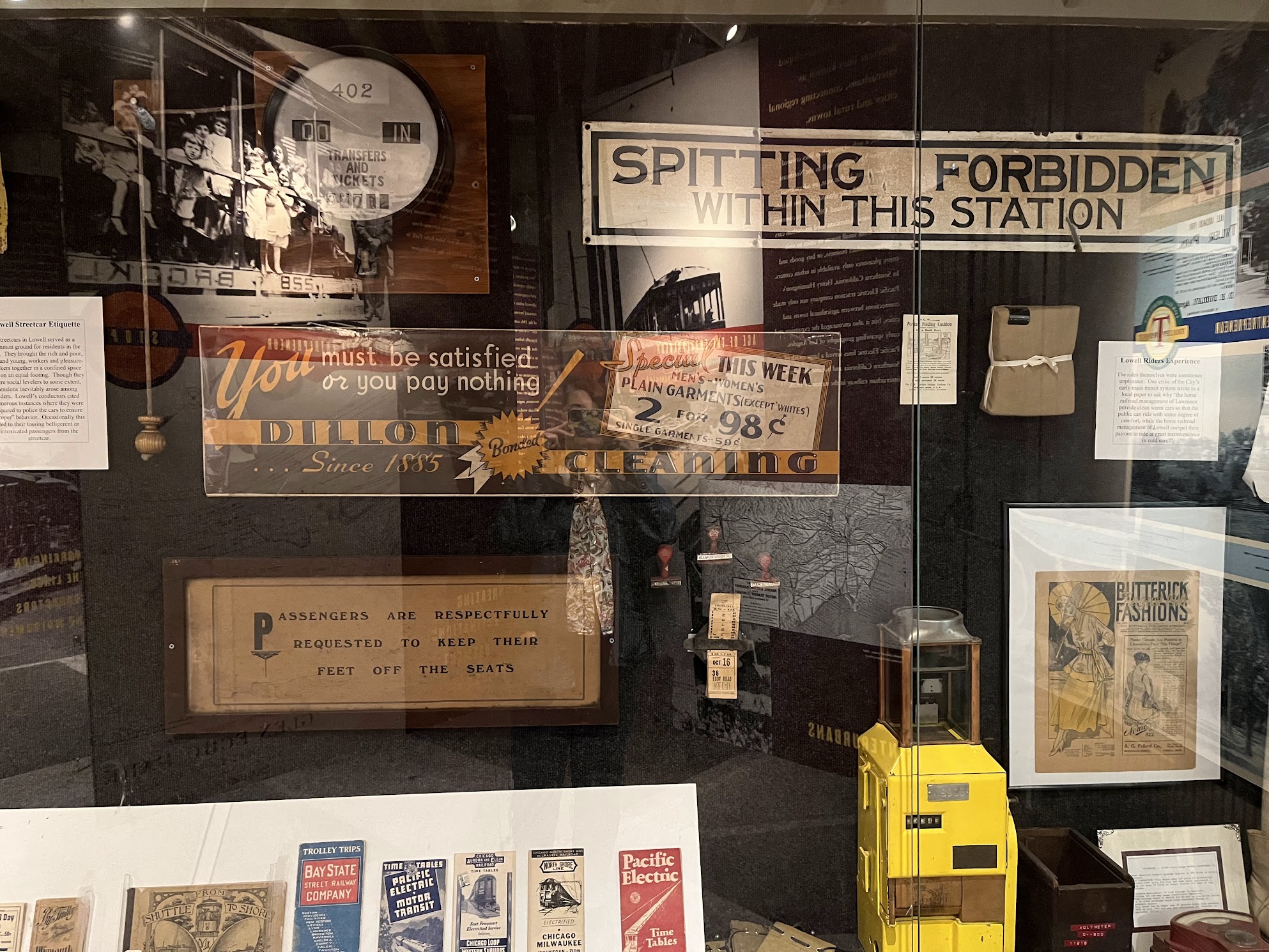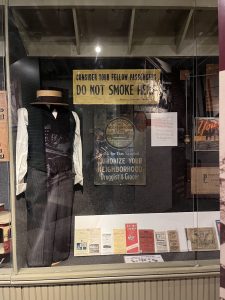National Streetcar Museum at Lowell – Exhibition Review

One recent gray Sunday I found myself in Lowell for a family event. Arriving early on the Commuter Rail, I had quite some time to kill in Lowell’s Heritage District. On my way to a sweet bookstore, I encountered a Boston & Maine locomotive and train car and found myself intrigued by a path of tracks, not a sidewalk, on the opposite side of the street from where I was walking, I found myself quickly searching online for open hours and, after that quick bookstore visit, dashing through the door when I saw a “trolley museum open” sign in front of the train.
As the helpful desk staff explained, the National Streetcar Museum in Lowell is a satellite campus of the Seashore Trolley Museum in Kennebunkport, Maine. Entry was $3 cash, with some youth discounts and an Eventbrite system to pay online.
The museum has two floors that I got to explore – an exhibition space downstairs and a children’s play area upstairs. The exhibition space has just a few glass cases and some text panels around the walls, and the majority of the interpretive panels are suspended floor-to-ceiling on cables. The way these are hung maximizes information in a small space but makes a narrative flow difficult to follow – and there is one. It’s train themed! There were eleven different sections labeled as different “stops” along the narrative through the exhibition, and these were interspersed with local history “Lowell Heritage Trolley Transit System” panels to create the Lowell and Boston connection to the greater themes.
Following the “route” through the museum based on the different topic “stops” was enjoyable and on-theme, but sometimes it was difficult to make sure I saw all of one “stop” before encountering the next one, then going back one stop to finish reading. The stops were:
- The Democratic Vehicle
- Age of the Entrepreneur
- Engineering Expansion
- Segregated City
- Converting From Rail to Rubber
- The Post-World War II Auto Suburb
- The Condition of Transit and the City
- Context For Change
- Electric Rail and the Regional City
- Building Communities
- People in Transit Today
There were more panels in the earlier “stops” that set up the historical context a bit more, but some of the way the interpretation and flow changed made me wonder if, originally, the whole museum mostly went up to Stop 8 or Stop 9. There was one panel each for 10 and 11, and I could totally see a point where it ended earlier.
There were a few interactives including a large streetcar front that you can stand on and take photos with (though there is not a lot of room to stand and take a photo without stepping back into a hanging text panel), and a wooden train play table downstairs. The real highlight upstairs is a whole train-themed children’s play area and program space. Outfitted with toys, activity stations, a controllable electric model train and wooden play tables, all interspersed with MBTA memorabilia like a ticket window and trolley benches inside a Lowell streetcar display, there is something for different ages and interests, from the crafts to cardboard blocks to photos. For big kids (like me), the activity space builds on the interpretive panels. For visitors from Boston, things are familiar just vintage.
I enjoyed their artifacts and wished there was more material and interpretation of them. They display men’s and women’s historic dress from the early 1900s alongside signs that encourage people to consider their fellow passengers on the Lowell streetcars, yet pair those with early system maps and timetables from other areas. There’s fun interpretation and nods to public health with the “Spitting forbidden within this station” sign, and some ticket stamps from recognizable neighborhoods including Clarendon Hill (Somerville), Allston-Union Sq (Allston), and Oak Square (Brighton). With an early Metropolitan Transit Authority (now MBTA) conductor’s uniform paired with some later MBTA system maps, these gave a more human element that was largely missing through the panels. My favorite artifact was the Lowell-Pleasant Valley rollsign curtain in the section that seemed to be more present-day and closer-to-home information. Unfortunately, in the main exhibition space there was not a lot of space for more cases, unless they chose to reinterpret where there is currently an old, staticky Toshiba box TV that plays 100-year-old film clips of transit.
The lighting is difficult in this space. Some panels are barely lit at all, and the lights reflect oddly off any of the glass cases. The radial panels are a challenging format to light, but this felt inaccessible at times. One thing I believe is a major error is that the trolley rides, run by the National Park Service, run Monday-Friday until June 15, but the museum is open Saturday and Sunday. In the early season, there is no way to take a trolley ride and visit the museum together, which I found frustrating!
Overall, the local history panels were informative, and visitors can definitely make this experience work for different audiences. The panels are not super easy to read, but the graphics are fun and there is something for all ages!
